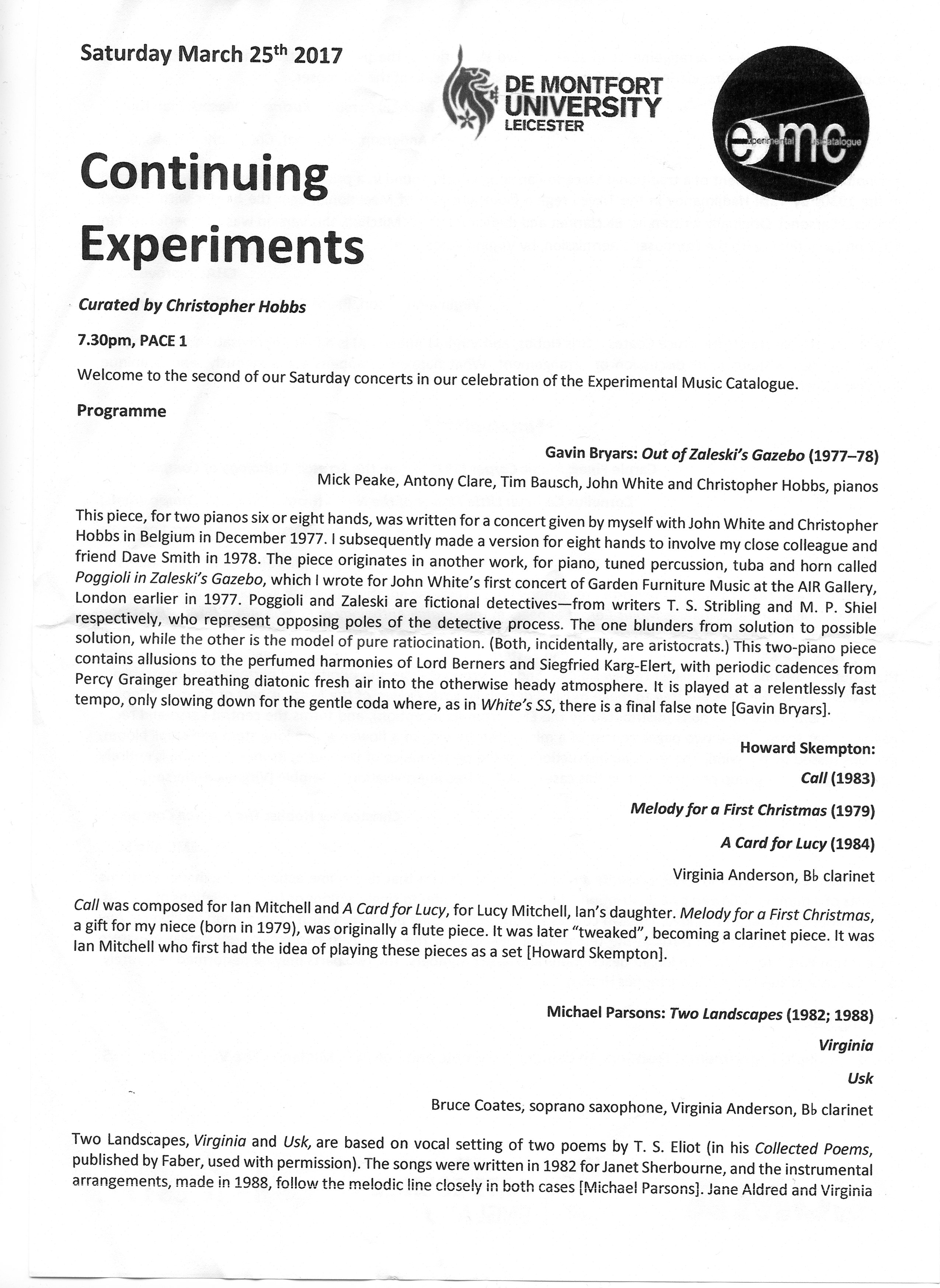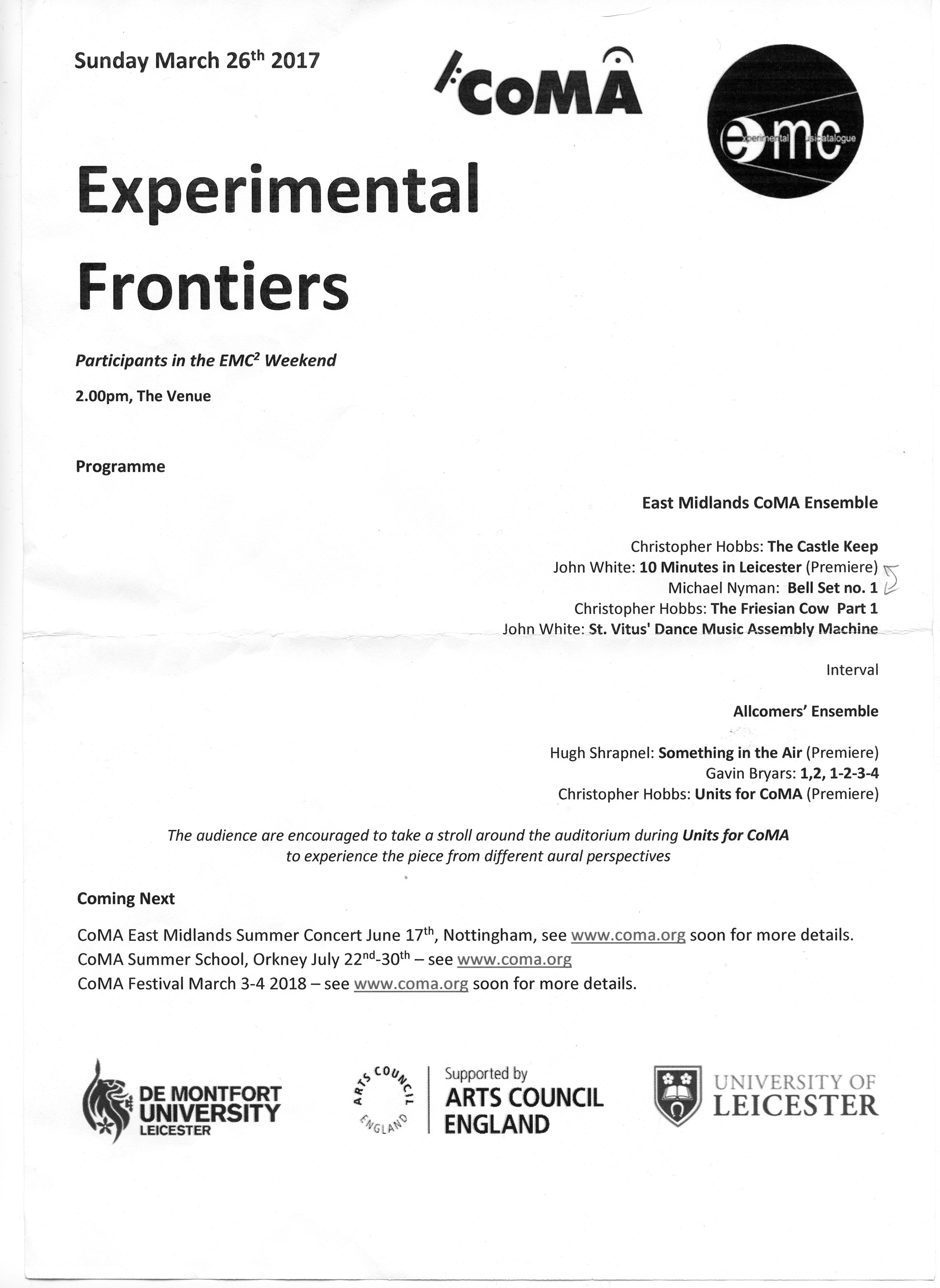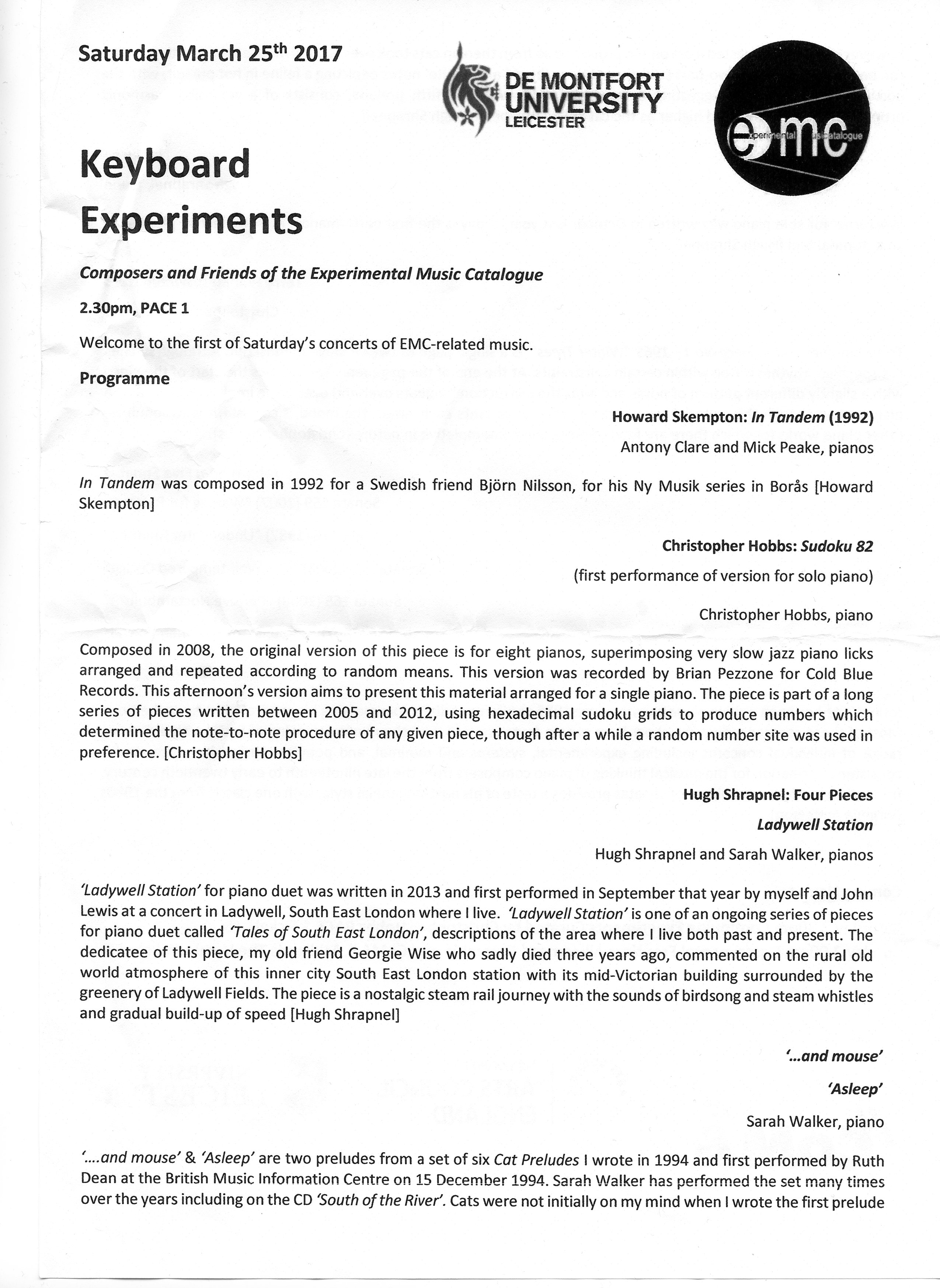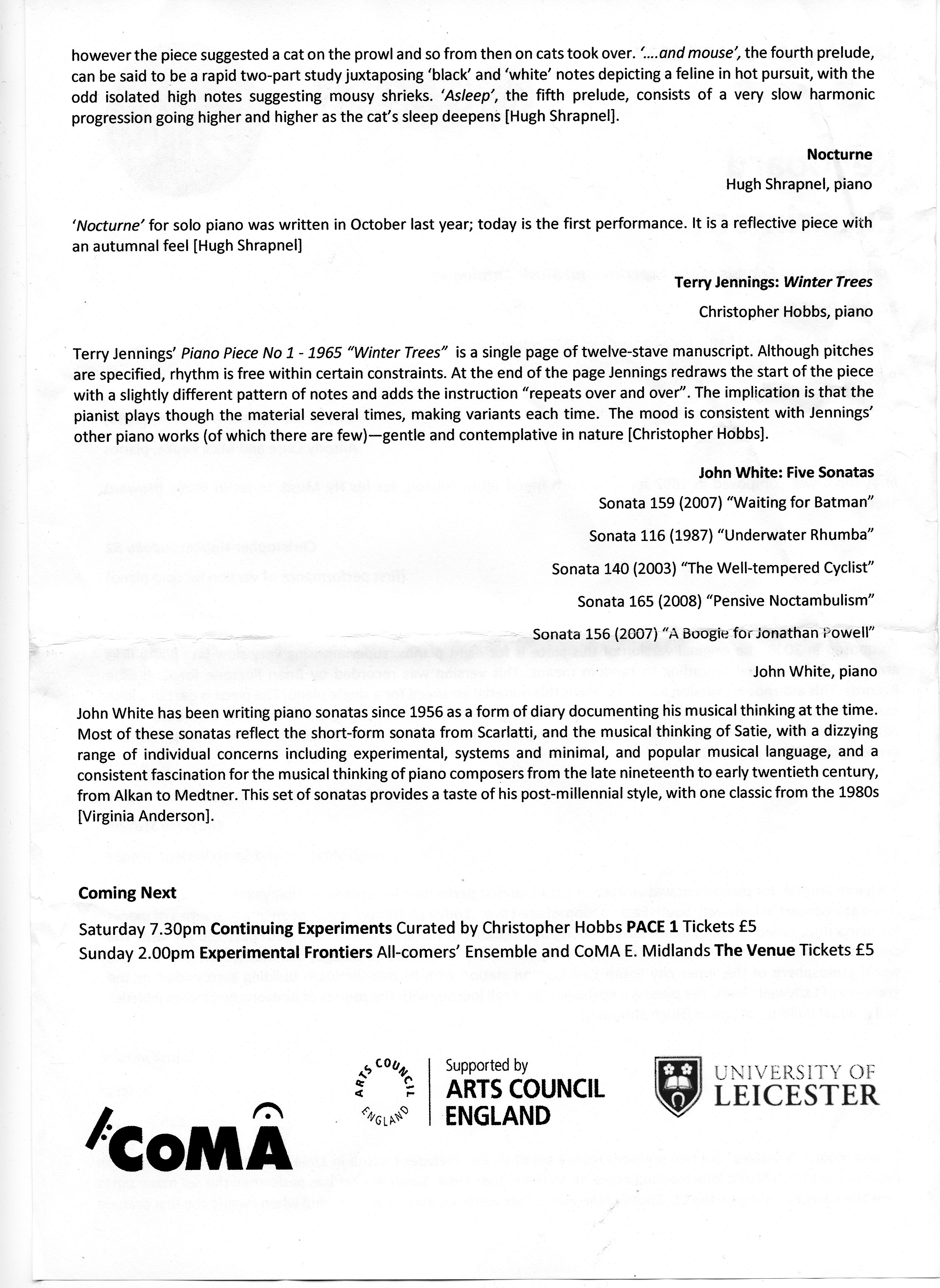Just as I posted a practice diary for Cornelius Cardew’s The Great Learning in two parts when we performed it in London in 2015, I thought I’d write down some musings about a set I am playing for the “Continuing Experiments” concert in the EMC²: Remembering the Experimental Music Catalogue weekend at De Montfort University, on 25 March (the whole festival runs from 24–26 March). My set includes pieces by Howard Skempton and Michael Parsons, and just as my diary for The Great Learning showed that indeterminate music using text notation took care and preparation, I hope to show that the so-called “New Simplicity” is not so very simple. In fact, this music demands what I have called elsewhere “virtuoso in miniature.”
I have been working some weeks on these pieces, which include Call (1983), Melody for a First Christmas (1979), and A Card for Lucy (1984)—all by Howard Skempton— and Two Landscapes (1982; 1988) and Kucinata (1988) by Michael Parsons. All of the Skempton pieces are for solo instrument; Two Landscapes was written in its 1988 version for two clarinets (but is being played as a duo for soprano saxophone and B-flat clarinet), and Kucinata is for clarinet and drum. This Monday I rehearsed Two Landscapes with the saxophonist Bruce Coates and last night Chris Hobbs and I obtained a bata drum for Kucinata (kindly lent by Lee Allatson, who runs the Dye House Drum Works in Leicester). Thus this first diary entry finds us well along the way toward performance.
The issues that arise in playing this music are specific to each piece, and in this entry I shall deal with a description of the first piece and its challenges. Call consists of a number of phrased events ending with fermatas and separated by one-beat rests with fermatas. Many of the events are repeated—eight different events, followed by a repeat of the first seven, with an extended version of the eighth, and concluding with even events of related, though mainly different, material. The dynamic is piano throughout with a musical instruction of “gently flowing”. The events are all primarily disjunct, mainly arpeggiated. There is no tempo marking.
I asked Howard Skempton about the tempo on all three of these pieces. I had thought that, though it was an excellent performance, John Corbett’s tempo on Call (on the album Surface Tension, Mode Records Mode 61, 1998) was slower than I would like. The composer’s answer was simultaneously helpful (in that it was clear) and unhelpful (in that it did not provide a solution): “There is no fixed tempo. If I’m ever asked about tempo, I always say that the right tempo is the tempo that allows for the possibility of rubato. Which doesn’t mean that I’m encouraging the use of rubato. I’m just welcoming it where it seems natural. And it will seem natural if the tempo is right.” Thus I had to find the tempo and durations of the pauses for myself.
The solution essentially is to study, play and think. The title, Call, originally suggested to me a kind of trumpet or bugle call, or perhaps something like the “Scène aux champs” of Hector Berlioz’s Symphonie fantastique, in which shepherds, represented by a cor anglais and offstage oboe trade melodic calls (ranz des vaches) in the evening at some distance. Skempton’s Call certainly has the flavour of the crepuscular: of taps, perhaps. But then I was listening one early morning to birdsong, just after the dawn chorus had died away. In particular, the blackbirds shaped their calls of motives separated by short pauses. Each repetition was exactly, or almost exactly the same; the motives varied before a repetition would begin. This turned the idea of the crepuscular call into a new area for me: instead of the military or lonely shepherds, the call was birdsong; the twilight was dawn, not dusk; and the musical sound world, although remaining clearly in Skempton-land, tilted away from Berlioz and closer to the territory of Olivier Messiaen.
This dramatic “note” on which to approach the piece gives me a way into the restraint that Skempton’s music always needs, and the tenderness that commonly exists in the pieces. Like the blackbird, I could state the repeated motives almost exactly the same way each time (though I am already stepping away from a literal repetition as I understand the piece’s semantics), while I can work the emotional content into the new material, which, beginning a little past the two-thirds mark of the piece, acts as a kind of conclusion to the piece’s “argument”. The first event that really concerned me was the third one, a set of quaver and semiquaver triplets. These cannot be played in any other way than as swung, jazzy quavers. Philip Clarke, in Gramophone, focuses on this event:
Carefully placed around Call’s largely open-ended, downriver rhythmic currents is a motif knitted together from “swung” quavers, which right away evokes Benny Goodman and Artie Shaw, and reminds you how often English composers of a certain generation and aesthetic persuasion, writing their generic fast-slow-fast wind concertos and sonatas, try to sex up their pallid rhythmic oom-pahs with a jazzy shot in the arm.
Skempton – clever him – manages to have it both ways, though. That momentary sense of swing is like a wry slap on the wrist, delivered entirely without rancour or hectoring, towards such transatlantic tendencies. But he also wants listeners to derive pleasure from those peaks of rhythmic exhilaration, and so gives them prominence in the structure like a punctuating semi-quote, a knowing reference to material from outside his orbit. You hear, you enjoy, and then think about how more cavalier composers freeload off the gestural surface of jazz. [http://www.moderecords.com/catalog/061skempton.html]
As much as Clarke likes Skempton, I cannot see how his description tallies with my experience of Call. The swung-quaver event could sound like parody jazz and that approach would knock the piece right out of its soundworld. Yet to try to work against the jazz reference is pointless. Here the even-handed performance of the blackbird provides a guide. When I first moved to my present house, we had a blackbird resident in our garden that Chris Hobbs and I called the “St Louis Blues Bird”. Like all blackbirds, this blackbird had a wide repertoire of short songs, one of which sounded exactly like the opening four notes of “St. Louis Blues” in exactly the right rhythm and nearly the right pitches, although the last note of was more of a croak than a pitch. This bird sang his blues call in the exactly way—within the same dynamic range and the same shape—that he sang his other calls, only with proper swung rhythm.
I am therefore working to play these calls within a consistent character throughout. Not that they will be identical, as there is a progression of argument, a passage of time and thought that moves through the piece as a whole. But the swung quavers, still carrying its “jazz” signifiers in the shape of its notes and durations, are to be played using the same calm, considered rhetoric of the other, non-jazzy, events. And this is what I mean by “virtuosity in miniature”: with Skempton, you are out on the tightrope. Having so few notes, there is no way to fudge or elide or hide errors. If I rise to an altissimo note (which happens in many of the events) and squeak or hit a harmonic, if I don’t slip smoothly from one note to the next without a break, I might as well wear clown pants and drop them at that moment. A scary thought, indeed.
This diary will continue as I have time to write it.





